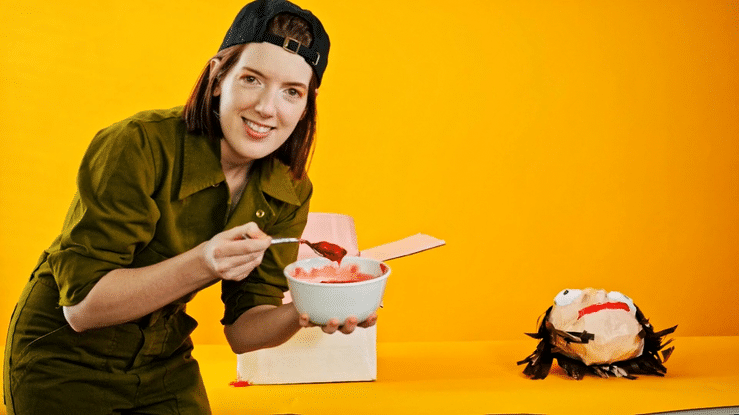BIO
Taylor Lee (b. 1991, they/them) is a queer artist, curator, and self-described “garbage person” who uses low-brow materials in the genre of kitsch and craft. Their personal experience of Grief is rooted deeply in the work. The performance of the Self is also a core theme, and they often experiment in installation and performance art. Lee’s projects range across many media and often culminate in autobiographical installations (both online and offline) that are interactive as collaborative relational aesthetics.
Lee recently exhibited a body of work entitled YARD SALE at SPRING/BREAK Art Show LA. This solo exhibition was curated by Janet Loren Hill and Jonell Logan, who won the first and only Single/Palm Award for “Best Curation.” The exhibition was also featured in Hyperallergic and Artnet. A visitor of the installation said “it looks like a redneck Pee Wee Herman lives here,” and honestly that’s the goal.
Lee has exhibited at galleries across the United States, most notably Hashimoto Contemporary, Wassaic Project, Collar Works, Standard Space, Redux Contemporary, and McColl Center. Their works have appeared in The New York Times, Vogue, Oprah Daily, Nylon, Boston Art Review, and The Jealous Curator among others. Recently, Lee created paper mache heads for Bowen Yang and John Higgins for the new movie Please Don’t Destroy: The Treasure of Foggy Mountain, streaming now on Peacock.
Lee’s most recent body of work was installed in a U-Haul cargo van. This installation, entitled BORN TO RUN, was both homage to American road trip culture and also a eulogy for Lee’s marriage (which is now over).
Lee is currently based in Charlotte, NC, working primarily out of McColl Center.
—
All inquiries can be made via hello@taylorleenicholson.com.
Artist Statement
I am always circling the same themes, the same habits, the same objects—rearranging them, remaking them, never fully moving on. My work is an exploration of cycles: the ones we choose, the ones we inherit, the ones we struggle to break. Through sculpture and installation, I trace the patterns that shape a life—grief and recovery, function and failure, transformation and stasis. Objects anchor these cycles. A wheel-thrown vessel, spun into existence, collapses under its own weight. A mop bucket sits in the corner, waiting to be used, emptied, used again. A crumpled fast-food wrapper lingers longer than the meal it once contained. I collect these moments of repetition and disposability, rendering them permanent in an effort to make sense of them.
Much of my work reflects the Everyday—the remnants of cheap meals, the refuse of road trips, the detritus of maintenance and survival. These things tell stories, even if we try to throw them away. In past work, I mapped grief through the vast, unending landscapes of the American West, the “road trip” an odyssey of both freedom and entrapment. The mess in the car—the receipts, the crushed cans, the piss-filled Gatorade bottles—became the real souvenirs, proof of movement, but also of stagnation. The journey is never really over.
Now, I look at the mechanics of change—how transformation is never clean, how growth is never linear. In my BUMMERS ceramic series, vessels are thrown, bisqued, glazed—some emerge functional, others fail. Some hold water; some crack. I incorporate digital artifacts like text messages and push notifications—echoes of past selves, repeated conversations, evidence of what is said and unsaid. The line between function and dysfunction is thin, both in my work and in my life.
Beyond vessels, I build sculptural tableaux that reflect the tension of cycles—cleaning products arranged like relics, objects of maintenance both literal and metaphorical. Getting Clean becomes a layered phrase: a ritual of labor, of sobriety, of control. But disorder is inevitable. The bottle spills, the saltine crumbles, the vessel collapses. Even in the attempt to create order, entropy creeps in.
At its core, my work asks: What if I can’t escape my cycles, of work, of addiction, of memory? I don’t have an answer, but I document the question. My practice is about repetition, about effort. I keep making, keep throwing, keep moving, even if I’m circling the same drain I’ve always circled. Maybe the cycle itself is the story. Maybe that’s enough.



